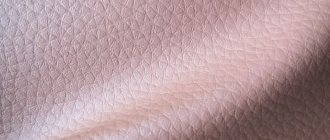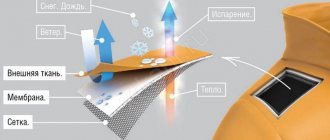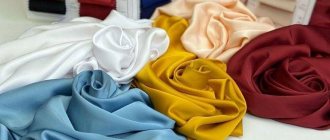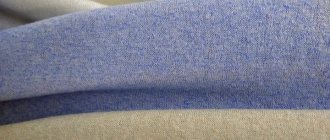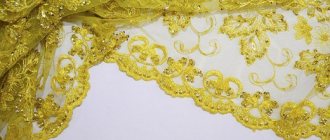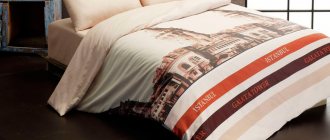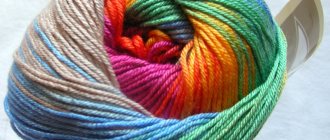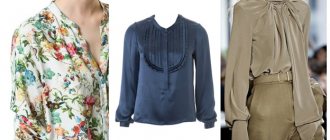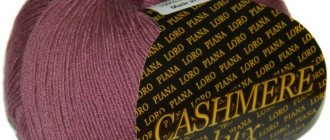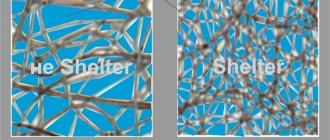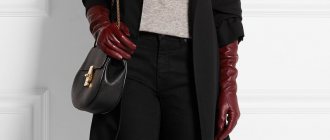Genuine leather is prestigious and expensive. Therefore, manufacturers strive to offer consumers a cheaper and more worthy replacement. Eco leather, PU leather are relatively new names on the market. Most often, they characterize the same material - soft, textured, not at all reminiscent of rough leatherette or dermantine. It is not surprising that questions arise: is this product natural or artificial, and why is polyurethane (PU) in the name? Since the cost of the new product is more than tempting, it’s worth figuring out what it is, PU leather, and how to determine that it’s what you’re looking at.
What is PU leather
PU (PU, polyurethane) - all these are the names of artificial leather, which is classified as the second generation of leather substitutes. And this, of course, is not leatherette or leatherette, the properties of which we know first-hand. However, PU leather and genuine leather cannot be equated either. Although the first material is very similar to it in terms of characteristics and properties.
Before we move on to studying the features of PU leather, let’s get acquainted with the history of the appearance and development of artificial leather in our country.
A little history
Many names have been invented for substitutes for natural materials, many of which have long since taken root in our language, and we have managed to get used to them. And often, remembering that in the 90s the markets were filled with clothes made of low-quality synthetics and shoes made of low-quality leatherette, out of habit we consider everything unnatural unworthy of attention. Although the situation has long changed. And artificial is not always synonymous with low-quality.
Artificial leather has been produced on an industrial scale in the USSR since the 1930s using technology borrowed from the pulp, rubber and textile industries. The first artificial material was tarpaulin, from which boots were made for the army. The new type of leather, naturally, could not be a complete replacement for natural material, since its properties were much worse.
In search of a worthy substitute for natural leather and to preserve the lives of animals, scientists conducted new research and experiments. However, the newly obtained leatherette material was again much inferior in quality to natural leather. It was a toxic material with an unpleasant chemical smell. It did not allow air to pass through and did not absorb moisture. Nowadays this material is practically not used due to its tendency to abrasion and low wear resistance. Nevertheless, a prejudiced attitude towards artificial leather in general has been formed.
By the way, leatherette is not slang or a popular name for the material, but the real thing. It is essentially cotton fabric with a layer of nitrocellulose applied to one or both sides.
PVC leather (PVC, polyvinyl chloride) or leatherette is another type of artificial leather. It is made entirely of polymer materials. A film coating made of polyvinyl chloride with the addition of various ethereal impurities is applied to a non-woven or woven base. This makes leatherette more weather resistant. However, it accumulates moisture and does not allow air to pass through.
If a layer of PU leather is applied on top of PVC, the material becomes very similar in appearance to natural leather. Taking advantage of this, sometimes unscrupulous sellers pass it off as eco-leather.
Almost simultaneously, the Americans (in 1963) and the Japanese (in 1964) invented a material made from synthetic fiber - polyurethane. It was called eco-leather and put into production. The new type of leatherette received the prefix “eco” because polyurethane in finished products does not emit toxic substances.
The material turned out to be resistant to stretching, loads and temperature changes. Elastic, soft, without an unpleasant odor and completely unlike leatherette or leatherette. And thanks to the natural fabric base and the top layer of PU film with micropores, the artificial leather had excellent air permeability. But for all its advantages, PU leather is still an artificial product. And its composition and properties depend on the production method and technological features.
Introducing stretch leather
Stretch leather occupies a strong position in the fashion industry market. Present in the collections of fashion designers who like to use it for tight dresses and skirts, trousers and leggings, as well as in decorative elements and accessories. Why is this and what is stretch leather?
It is a thin and elastic material that stretches without cracking or damage. It consists of several layers, where the base is cotton fabric, on which a polymer coating is applied on both sides. The textile layer may contain the addition of elastane, polyacrylic or polyamide. The artificial knit base gives the skin stretch by 30%.
The surface of the material attracts with its varnish smoothness and shine. The canvas is also produced with a matte front side.
Stretch leather is used to make clothes, handbags, coats, suits and shoes. The products fit tightly to the body, emphasizing the dignity of the figure and sexuality.
The most popular material is black, although it is available in a rich palette.
Modern technologies make it possible to obtain natural stretch leather by combining a layer of thin sheepskin with a cotton textile base. The material is of high quality and durable, with the ability to stretch by 20%. Looks attractive.
Types of PU leather
PU artificial material is produced in two types:
- 100% polyurethane is an artificial leather made entirely from polymer materials using a chemical method.
- Fabric with a top layer of PU coating, the production of which uses pieces and trimmings of natural hides left over from the tanning industry. In processed form, natural raw materials are applied to a polymer or fabric base and coated with polymer on top for wear resistance.
In both cases, high-grade polyurethane can be used in the manufacture of leather. Both as a filler and as a covering for defective skin. It is applied to a cotton fabric base, on which a breathable microporous film is formed. The thicker the coating layer, the better the quality of the material.
At the same time, the thickness of the coating is determined by the purpose of the skin. To sew trousers and skirts, soft elastic leather with a smaller layer of top covering is required. In the production of furniture upholstery, on the contrary, a more durable and rigid material is needed.
Composition - decoding of PU value and formula
Polyurethane is safe for health, which is why the name received the prefix “eco” (eco leather). This is a porous multilayer material obtained by synthesizing organic and inorganic components: polyethylene, rubber, cellulose.
The composition of the eco-friendly material is mixed; it contains various chemical elements. Animal skins are not used in production, which helps preserve natural resources.
Expert opinion
Alyona
Fabric expert and technologist Alena Khlebnikova is ready to answer your questions.
Write to us
It is difficult to distinguish eco-leather from its natural “double” from a photo. The material has a similar texture and outwardly resembles the pattern of the epidermis. The composition of polyurethane fabrics for the manufacture of leather goods, upholstery and clothing includes different components: cotton fabrics as a base, a pressed layer from tannery waste, and a polyurethane coating.
PU fibers are used in the production of textile materials: lycra, spandex, neolan, vorin. These fabrics contain from 2 to 5% polyurethane fibers. A typical representative of the group is Oxford material, as well as technical textiles with one- and two-sided polymer coating.
The formula of a urethane group polymer looks like this: −N(R)−C(O)O−, where R is H (hydrogen), alkyl, aryl or acyl. In chemistry, the substance is called PolyUrethane, hence the abbreviation for the material - PU (PU, PUR).
How is polyurethane leather made?
PU fabric is a multi-layer and high-tech product. Its structure and properties resemble natural leather. The secret to obtaining a material with properties close to natural leather lies in its manufacturing technology.
The new generation material PU leather consists of several layers: base, filling and coating. The quality of PU leather directly depends on the combination and properties of the materials used in them, on the number of layers and their thickness.
The first layer (bottom) is the base. Most often, this is cotton fabric, less often - knitted or non-woven materials. The natural base, resistant to stress and stretching, makes the fabric “breathable”.
The second (middle) layer is most often a natural material treated with polymer mixtures in the form of crushed, compressed, glued together with a binder, which is applied to the first layer of the fabric base. This layer distinguishes PU leather from cheap leather substitutes.
The third layer (top) is PU coating. It consists of polyurethane applied to a base consisting of a bottom cotton layer and two or three layers of compressed defective natural material in the form of a polymer breathable film at temperatures from +130 °C to +160 °C. The name PU leather comes from the name of this polymer.
At the same stage of production, the leather is dyed, patterns and embossing are applied to it, creating a surface of different textures. In this case, the internal layers are not affected in any way. Only the top layer of the canvas, which is resistant to deformation, is processed, painted and decorated.
The three-layer “pie” technology provides the material with characteristics similar to natural leather: tensile and tensile strength, softness, frost resistance, and hygiene. In this case, no additional chemical additives are used. All the properties required for this process are already synthesized in the polymer. The polymer film does not emit anything dangerous or harmful during operation.
Specifications
PU leather is often found on the labels of leather goods and clothing products; what it is, the description of the main properties given in the table will help you understand:
| Characteristics | Indicators |
| Raw material type | Synthetic |
| Purpose | Production of footwear, clothing, furniture upholstery, technical products (including medical) |
| Density, g/m2 | 500 ± 50 |
| Standard width of canvases, cm. | 140 |
| Water resistance | High |
| Hygroscopicity,% | 1 – 5 |
| Moisture absorption rate | Minimum |
| Fabric structure | Natural or synthetic base with polyurethane coating |
| Side | Right front |
Open to see the entire table
| Air exchange indicators | Minimum |
| Vapor permeability | Low |
| Electrification | Minor |
| Tensile strength | High |
| Peculiarities | When heated and deformed, it does not lose its properties. With high hardness, it remains elastic and does not crack in the cold. |
| Dynamic voltage limit, t, °С | 120 |
| Deformation limit, % | 350 |
| Pressure resistance, MPa | 50 |
| Temperature range, t, °С | + 60 ÷ — 70 |
| Coloring methods | Plain painted monochromatic coating |
| Color palette | Extensive |
| Manufacturer | China, Russia, Belarus |
| Standardization | GOST R ISO 7617-3-2011 |
| Price | Affordable, on average from 500 rub. for 1 meter |
Material properties
Similarity to genuine leather and environmental friendliness are the main advantages of high-quality PU leather. In addition to the affordable price, eco-leather is characterized by a number of valuable properties.
- The structure of the material replicates the flexibility and plasticity of natural leather. It is lighter than artificial leather and genuine leather.
- It tolerates temperature changes well: in the cold, PU leather still remains soft and does not tan, and in the heat it does not heat up and is well ventilated through the micropores of the top layer of the film.
- Resistant to wear and mechanical stress: does not crack, tear, or stretch during wear.
- The microporous structure of the material does not prevent the skin from “breathing”. The material wicks away sweat and does not accumulate moisture. This is important in the production of shoes and clothing from PU materials.
- It does not have an unpleasant synthetic odor and does not cause irritation or allergies.
- Lightweight, elastic, soft material looks like genuine leather.
- Decorative polyurethane coating gives products fashionable shades and texture.
- PU leather is an inexpensive replacement for genuine leather products. Moreover, brands include a large number of leather products in their collections.
But just the presence of the designation “PU leather” on the label does not guarantee that all products made from it are of the same quality. To verify this, let’s compare PU leather with natural and PVC leather according to the main parameters.
Morocco bags – what are they?
Michael Kors has been actively using saffiano leather in its collections for many years. The brand, in a sense, became associated with morocco. Casual, formal office bags, wallets, clutches, crossbodies - you can choose a model to suit every taste.
You can see saffiano leather on bags from such famous fashion houses as Prada, Furla, Cerruti, Celine, Burberry, Salvatore Ferragamo, Gucci, Dolce & Gabbana, Cerruti, Paul Smith. As a rule, they produce the same bag model from different materials.
It's not just luxury brands that use embossed leather. Bags and accessories made from it are found in the collections of relatively modest companies Fabi, Baldinini, Le Tanneur, Longchamp, Enquer, Brooks Brothers, Montblanc and others. Saffiano leather backpacks and belts are also produced. Sometimes it is combined with other materials.
What is the difference between PU leather and genuine leather?
PU leather, made entirely of polyurethane, imitates the structure and structure of natural material in appearance, properties and quality. There are more similarities between them than differences. Both types of leather do not change properties in the cold, maintaining plasticity and softness at sub-zero temperatures.
In terms of breathability, eco-leather is almost equal to natural leather: it “breathes” well and absorbs moisture. In terms of texture and smell, artificial leather almost completely imitates the properties of natural material thanks to fragrances and special processing. The PU material, depending on the base, is not inferior in elasticity to its natural counterpart, which stretches well without tearing.
At the same time, PU leather is a more durable and wear-resistant material. Genuine leather becomes abraded over time. The artificial analogue is more resistant to ultraviolet radiation, chemicals, high temperatures and does not form abrasions. Another advantage of PU leather is its price. Products made from this material are several times cheaper than those made from genuine leather.
Signs by which you can distinguish genuine leather from PU leather
It is very difficult to distinguish high-quality PU leather from natural leather by external signs. It will be just as warm when you touch it and will smell just like natural. If you drop a few drops on the material, natural leather, like PU leather, will immediately absorb it and darken. But if the fabric base is visible on the cut, this is a sign that the leather is artificial. In addition, the cut edge of genuine leather is slightly thicker.
You can navigate by the label, which contains information about the lining and base of the product. But here you need to learn to understand what this or that marking on the tag means. For example, the sign “skin with a diamond” shows that the clothing is made from defective natural fabric coated with polyurethane. The diamond-shaped sign indicates an artificial analogue. The hash mark is an indicator of the textile composition.
Physico-chemical qualities of polyurethane
Important properties of polyurethane include:
- temperature resistance (in the range of -20...+100°C, the material retains all mechanical properties, can withstand cooling down to -70°C and short-term heating up to 140°C);
- water resistance;
- resistance to solutions of salts, alkalis, oils and many solvents (damaged by nitric and chlorine-containing acids, dissolved by acetone);
- dielectric properties;
- high elasticity and mechanical strength;
- resistance to abrasion and deformation;
- withstands long-term use.
Advantages:
Polyurethane has good performance properties: it weighs little because it has a porous structure, has good abrasion resistance, is flexible, has excellent shock absorption and good thermal insulation. The soles made of polyurethane are light and flexible, therefore they are used in shoes where these characteristics are of particular importance.
Flaws:
The porous structure of polyurethane is also a kind of flip side
of the coin . For example, because of it, polyurethane soles have poor grip on snow and ice, so winter shoes with PU soles slip a lot. Another disadvantage is the high density of the material and loss of elasticity at low (from -20 degrees) temperatures. The consequence of this is fractures in the places where the sole bends, the speed of which depends on the characteristics of the use of the shoe, in particular, on the person’s gait, the degree of his mobility and other factors.
Comparison of PU leather with PVC leather
Cheap leatherette and polyurethane leather differ greatly in properties. This is due to the technology of their production and depends on the chemical compounds used.
PVC leather is inferior to PU leather in many respects:
- plastic (polyvinyl chloride) in the base, hidden under a layer of top PU or PVC film, is toxic and can cause allergies;
- makes products hard in the cold, breaks and becomes tanned, while products made from PU leather retain their properties from -20 to +80 °C.
- leatherette - the material is inelastic and inferior in service life, over time it delaminates and cracks;
- PVC leather is cold to the touch, with a pungent chemical odor;
- PVC film does not allow air to pass through and does not absorb moisture - this is its main disadvantage and its difference from high-strength and frost-resistant polyurethane with breathability at the level of its natural counterpart;
- The only advantage of leatherette is that it is cheaper than PU leather.
How to distinguish natural material and PU leather from low-quality leatherette
The material will not heat up when you touch it with your hand. It will not absorb a drop of water applied to it due to the fact that it does not allow moisture to pass through. It will smell like synthetics and plastic. If the leather shows signs of delamination, then it is not PU leather or natural.
Advantages and disadvantages
You should always pay attention to the pros and cons, this will help you decide whether this material is needed or not. Pros:
Pros:
- You can make pieces of different shapes and sizes. It is because of this parameter that it is well used in making various bags with a variety of colors used.
- Cheaper than natural. And all thanks to the fact that it has impurities.
- Very low water permeability. Because of this, leather is very often used in the manufacture of bags and shoes. After all, after wearing in the rain, your bag or shoes will not be wet.
- Suitable for embossing lettering.
- Not difficult to care for. You should care for it in the same way as other artificial leather.
- Huge selection of colors. Due to the possibility of using different colors, recycled leather is often used in furniture. People have the opportunity to choose a sofa of the color that suits the interior.
Color spectrum
- Wide selection of upholstered furniture models.
- The ability to make the same pattern as on real skin: crocodile or snake. The choice of texture is varied. It all depends on desire.
Disadvantages of the material:
- Poor tolerance to cold. This means that cracks may appear at very low temperatures.
- Poor breathability.
- Not suitable for making shoes. The main reason is that after two or three months the shoes may burst.
Furniture made from recycled leather will fit into any interior due to its advantages. Buyers should choose the right manufacturer. And the latter needs to choose the right supplier who provides the material.
What is recycled (pressed) leather and how is it different from natural leather?
Recycled leather - pu leather (bonded leather, reconstituted leather) - a cheaper analogue of natural leather. In its production, scraps of natural leather, leather shavings, thermoplastic resins and artificial fibers are used: polyethylene, polyesters, polyamide.
The pieces of skin remaining after cutting and processing are crushed and turned into “leather” flour. A binder material is mixed into the fibrous powder. The finished mixture of synthetic and natural fibers is melted. As a result, all components combine and, after cooling, a substance is obtained that feels and smells like leather.
In terms of properties, pressed leather cannot be equated to natural material. Since chemical components are used in its production. It is not superior in quality to artificial PU leather.
The material allows water to pass through (critical for shoes), but does not allow air to pass through. The structure of the canvas without a high-quality coating and base quickly collapses. When comparing modern PU leather and pressed leather, the advantages are on the side of the former.
By what signs can you distinguish pu leather from natural leather:
- press leather base – fabric or non-woven fiber;
- the surface of the canvas is uniform, smooth;
- there is a specific chemical smell;
- the material is cold to the touch and does not adjust to body temperature;
- When heated, it melts, releasing a pungent chemical odor.
Questions and answers
Question: How to properly care for the material?
Answer: Saffiano leather does not require lubrication. Caring for it comes down to wiping with a damp cloth. It is recommended to use a microfiber cloth, which best absorbs dust and dirt. If your bag suddenly gets wet from rain, you can dry it away from heat sources in a dry, ventilated area. If after drying it becomes rough, a special moisturizing balm will help save the situation.
Question: How to distinguish natural saffiano leather from artificial leather?
Answer: First of all, products made from natural raw materials are expensive, have high-quality fittings, neat seams, tags with an article number (serial number) and a QR code inside. You can distinguish saffiano leather from a substitute by checking it with the original embossing pattern and by touch. Natural material is softer. Although it is dense, it is elastic. The leatherette is “oak” and has a stronger shine.
Saffiano leather today refers to embossed saffiano leather. Often, products from a substitute are produced with similar embossing. In both cases, it is a strong, wear-resistant material that requires minimal maintenance. It is important not to confuse saffiano with antique morocco, a brightly colored soft goatskin. They have one thing in common - a similar name.
What is special about polyurethane coated leather?
In this case, the polyurethane coating is applied not to a fabric base, as in eco-leather, but to natural animal skins with any defects or improperly processed. The polyurethane top layer solves two problems: a painted decorative PU coating with characteristic embossing corrects flaws in the natural material and at the same time preserves the properties of the natural base in the product.
What is sewn from PU fabric
An artificial material made of polyurethane with a decorative surface reminiscent of luxury expensive leather is used by designers to realize their ideas in many industries: in interior design, in the manufacture of various accessories, furniture, and clothing.
They sew from PU leather:
- shoes;
- women's and men's jackets and other outerwear;
- gloves and belts;
- purses and wallets;
- covers for phones, laptops, cameras;
- bracelets for wristwatches;
- suitcases, bags and backpacks;
- upholstery for furniture and cars;
- sporting goods: knee pads, protective masks, balls, gloves, helmets.
Application
Products made from polyurethane fiber
Fabric with elastane fibers has a fairly wide range of applications. It is important to understand that this raw material is not used in its pure form; it is added to weaving fabrics in small quantities to improve properties. Sportswear, suits, blouses, skirts, dresses and many others are made from stretch fabrics. etc.
Coated fabrics are used in the manufacture of protective suits, tourism and sports equipment. Eco-leather is used for the production of clothing, shoes, and haberdashery.
PU is most often used in sewing the following models:
- jackets, raincoats, coats with water- and windproof properties;
- rubberized awnings;
- insulated trench coats and jackets;
- shoes (sole and formation of the surface of the model);
- upholstery and covers for furniture, car seats;
- wallets, bags, backpacks;
- cases for phones and tablets;
- gloves, belts.
The elastomer is widely used in the production of medical supplies (bandages, bandages, compression products).
Advantages and disadvantages
Reasonable price, appearance and properties of genuine leather - all this, of course, appeals to buyers in polyurethane leather. Noting the advantages of modern artificial material in reviews, many highlight such qualities as softness, lightness, elasticity of the material, and comfort for the body. The price is quite satisfactory, which means you can please yourself with new things and update the interior more often.
Among the reviews there are also negative ones. For example, it is very difficult to get rid of pet scratches if they appear on polyurethane products. Furniture upholstery made from this material is also easy to ruin if there are small children in the house who like to paint wallpaper, tables and furniture with paints and felt-tip pens.
If clothes are made from cheap leather, they are not very comfortable in cold weather.
Reviews
Saffiano leather products are not for everyone. This conclusion can be drawn from mixed reviews on the Internet:
Victoria M.:
“When I first bought a Michael Kors saffiano leather bag, I had no idea that it was a great investment. I spent 10 thousand rubles. As a result, 5 years have passed, and the bag is like new. True, I have two other bags for my shift. But even if you only wear it day after day, it seems to me that the condition will not change. I don’t know how they achieve such quality, but it really justifies the high price.”
Natalya Klimenko:
“A very good bag, I would say indestructible. It doesn't rub and washes well. Regarding whether the leather is genuine or not, a person working at a leather factory said that now the fake is of such high quality that an ordinary person would not be able to tell the difference in life.”
Amina:
“The quality is good, yes. But I still don't really like my Saffiano leather Donna Karan. It reminds me too much of polyurethane.”
Larisa:
“I recently received a Michael Kors bag and was really disappointed. I always really like the smell of leather. And this morocco smells nothing at all. As I understand it, this is due to special processing. So you can see that the leather is natural, good quality. I liked that it holds its shape well. You can wear it. But it didn’t create a “wow” effect.”
How to care for eco leather
Products made from high-quality eco-leather can replace shoes and jackets made from natural materials. However, you need to care for them as carefully as for products made from genuine leather.
To remove minor stains, simply wipe the stain with a soft, damp cloth, then dry.
It is recommended to clean stains of organic origin with products intended for natural leather, following the instructions.
To improve the water-repellent properties of the product and extend its service life, it is recommended to treat the leather with special impregnations for natural clothing and shoes.
Answering the question: is PU leather synthetic or a natural product? We can say that it is an artificial material. Despite the partial content of processed natural leather, its production still uses high-tech chemical processes.
What about morocco boots?
Many people know about morocco boots from old films and books. They were worn by “good fellows,” merchants, princes and the entire wealthy class. The boots looked bright red, multi-colored, embroidered with gold, often lined with iron shoes, with an upturned toe. Women's boots were called morocco boots. For commoners they were a luxury.
For sewing boots, specially tanned leather was used - morocco ("sofyan" is an erroneous spelling). According to the definition:
Saffiano is an ancient type of leather, vegetable-tanned from goat skins and dyed a bright color. Currently not in production.
According to one version, morocco was named after the Moroccan city of Safi. The national footwear of Morocco, babouches (shoes without backs), was made primarily from embossed morocco. One way or another, the material was brought to Russia from other countries. Later, in 1666, its own production was opened. The technology was incredibly complex:
- Goat skins were soaked in water and then in ash pans.
- After the hair began to separate, it was collected on a block.
- The skins were returned back to the ash pit for 1-2 weeks to produce fat.
- The raw materials were flayed, and the front side was carefully shaved and made smooth with a stone.
- At the next stage, the canvases were washed under running water in special rotating barrels.
- For a flawless “face,” the skin was placed in wheat jelly, washed and passed through several vats of sumac juice.
- Then the sumac plant was tanned.
- After tanning, morocco was dyed in bright colors. Natural dyes were used - plant or animal (for example, cochineal mealybug). To ensure color stability, the leather was etched with a warm solution of stannous chloride or alumina mordant.
- Finally, the painted and dried leather was given a gloss finish. The surface was smeared with a mixture of dye, beaten egg whites, linseed oil and passed with force through a glass cylinder.
Sometimes a pattern was rolled onto the skin with a roller. Morocco boots were considered the best shoes and cost fabulous money.
Less commonly, furniture was covered with morocco and book bindings were made from it.
Mention of the material in the literature:
- “I put on morocco boots with carved designs of all sorts of colors.” Gogol, “Dead Souls”.
- “Like girls, in an elegant headdress of yellow, blue and pink haircuts, on top of which a gold braid was tied, in thin shirts embroidered along the entire seam with red silk and studded with small silver flowers, in morocco boots on high iron horseshoes, smoothly, like peahens, and with a noise like a whirlwind, they galloped in the turtle dove.” Gogol, Evenings on a Farm near Dikanka.
- “The red wide morocco sofa obviously served as Rogozhin’s bed.” Dostoevsky, "The Idiot".
- “These soft-bound books made of delicate green morocco are still with me.” Kuprin, “Sentimental Novel”.
Today, morocco products can only be seen in museums and ethnic exhibitions. They are part of history.
